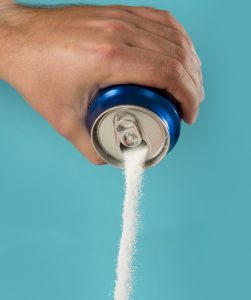How Much Sugar Are You Drinking?
According to the CDC, sugar-sweetened beverages are the leading sources of added sugars in the American diet. These drinks are associated with a variety of conditions, so limiting the amount of sugar-sweetened beverages is a good way for people to maintain a healthy diet and weight.
While people know they’re getting pure, clean water from Culligan New England, sugary drinks are less upfront about what is in them. While a sugary drink is okay to have as a treat, this information can help you understand why it shouldn’t be your go-to beverage.
What Are Sugar-Sweetened Beverages?
Sugar-sweetened beverages are defined as any liquids that contain various forms of added sugars. These additives include:
- Brown sugar

- Corn sweetener
- Corn Syrup
- Dextrose
- Fructose
- Glucose
- High-Fructose Corn Syrup
- Honey
- Lactose
- Maltose
- Molasses
- Raw Sugar
- Sucrose
Common drinks that have these sugars added include soda, fruit drinks, sports drinks, energy drinks, and sweetened waters.
The Facts Behind Sugary Drinks
According to the CDC, roughly half of the people in the U.S. consume sugary drinks on any given day. One in four of those individuals consume at least 200 of their daily calories from these drinks.
Additionally, one in twenty people will consume over 550 calories by drinking alone. Some popular drinks have much more sugar than you would like to believe. The picture to the right shows how many calories and teaspoons of sugar are in several popular drinks.
Additionally, one in twenty people will consume over 550 calories by drinking alone.
Soft Drinks and Weight
The average can of cola is around 150 calories, which come almost exclusively from the 10 teaspoons of sugar that is in each can. If the average person were to add a can of soda every day without cutting calories elsewhere in your diet, they could gain up to 5 pounds a year. Drinking water instead of these sugary drinks or fruit juices is associated with lower long-term weight gain in adults. Studies tend to agree that this effect appears to be stronger in women than men.
Secrets of Fluid Calories
Since fluids don’t provide someone with the feeling of fullness that solid foods do, the body doesn’t quite process liquid calories as well as it does for calories from solid foods. This will make a person still feel calorically unsatisfied even after imbibing a high-calorie drink. Another reason that these calories are sneaky is that people tend to limit food before beverages. Even though a can of Coke has more sugar and calories than a Twinkie, most people will opt out of a Twinkie before they opt out of a Coke. This is because most people see one as a beverage and the other as a dessert.
Before you crack open that next can of Coke or twist open that next bottle of apple juice, just take a second to look at the label. This isn’t to say that sugary drinks should never be consumed, but rather that it should be viewed as more of a treat, like dessert, than as a usual beverage. For your usual beverage, there is nothing better for you than water. And to easily get good, clean, pure water all you have to do is call your New England Culligan.
Sources:
https://www.cdc.gov/nutrition/data-statistics/sugar-sweetened-beverages-intake.html
https://www.hsph.harvard.edu/nutritionsource/healthy-drinks/sugary-drinks/
https://cdn1.sph.harvard.edu/wp-content/uploads/sites/30/2012/10/how-sweet-is-it-color.pdf